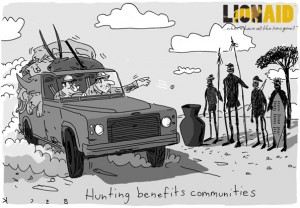News
Latest Lion Aid News
The Hunters' Lament
Saturday 5th November 2011
|
Nothing but a ban on imports will make a difference, as sport hunters will not regulate themselves, despite their claims of being conservationists. To my mind, they only conserve the taxidermy industry and corrupt officials. All feed at the trough of commercial exploitation of wildlife, and pass gas about conservation. Harsh? No, realistic. The more that is exposed about these practices the better, and this is why LionAid is urging for the only possible alternative – an import ban imposed for trophies by the countries where the clients live. In the USA, let the resident hunters shoot, per annum, 16.5 million ducks, 1463 cranes, 12,628 swans, 24,465 bears, 12 million rabbits, 2.5 million raccoons, 3.1 million geese, 35 million doves, 26 million squirrels, 615,148 turkeys, 6.1 million deer and who knows how many cougars, wolves, elk, wild sheep, moose – they claim it is their right, so go at it. That’s your wildlife heritage, but please don’t come to Africa. I have blogged before about a hunting website run by someone called Safaribwana. He organizes hunts for clients, and says he’s from Zambia while living in the USA. He’s a bit over the top in terms of his pro-hunting “massage”, but occasionally he gets it right. Please read this from his May 2009 post: “A good PH friend of mine was out on a hunt, far out in the western sands of Zambia in a vast and sparsely populated GMA. He was covering with another more fancy, flashy PH out of Zimbabwe, after Lion - a safari booked upon last seasons spectacular results. Day in and day out a young male would walk into the bait, big bodied but thin around the ears and shoulders, clearly a 3 or 4 year old boy testing his skills and territory. Other baits had strikes but the big one didn't show and as the safari started nearing its end the inevitable happened - the throw away youngster from day 3 now suddenly started looking like a shooter in the eyes of flashy pants and he started hinting to my friend that it may not be that young a male, perhaps it had a mane-less gene. Now, there are lions that don't grow manes, but you don't need a mane to clearly read the age of a male - it is clear if it is on the young side - and the much talked about black nose is not necessarily the indicator. Correct all “principals” as spelled to principles and you will get the picture. The young male was shot for sure! And this is from a man who supplies clients to trophy hunting organizations? Next comes this… “Up until a few years ago, the principle [correct spelling!] of a community benefitting from the wildlife on their traditional land was but a pipe dream. However since 2003 it was formalized in the GMA lease agreements and now the community had a Resource Board who would represent their needs and see to the efficient and prudent allocation of funds from the hunting revenues. Today 50 percent of the revenue from the trophy fees and 20 percent of the concession fees are allocated to the community for various projects and priorities. The chief for example gets a 5% cut while the majority of funds are allocated to employ local village scouts for anti-poaching work. The problems that exist within this system is the filtering down of funds to the intended grassroots recipients and often the most important ones like salaries for the village scouts is non existent. The process is hindered from the top down starting at the disbursement from the wildlife authority but also gets mis appropriated at resource board level and often scouts wait 6-8 months for their salaries. What do they do to feed themselves and their families during this time? Should they carry on their essential duty to the GMA or should they sit idly by and wait until their salaries are paid?”
So they all know the problem but continue hunting… and the continued message from sport hunters is that they greatly assist African communities? And then this: “A couple of years ago existing GMA's [Game Management Areas] were suddenly split into two or three and the existing safari operators were told they had to pay for another hunting concession as well as another quota of animals. Essentially it meant a GMA of 3000 square kilometers with an annual quota of 180 animal species was now split into two 1500 sq km areas each with an annual quota of 180 animal species? In any man’s book, this does not make ecological or conservation sense, in fact it simply does not make sense. However it does make a whole lot of sense numbers wise to certain operators looking for more hunting land that they had perhaps missed during the initial GMA allocation and it makes even more dollar sense to the wildlife authority.” So there you have it. All in the sport hunting community – the officials, the governments, the operators, the professional hunters – are looking for short-term profits. Not their conservation claims, not their community assistance claims- dollars and euros please. Will we stand up to them?
Picture credit: BeCK/newtoonsontheblog.info Tags: lions, trophy hunting, professional hunters, Categories: Trophy Hunting |
Posted by Pieter Kat at 14:55
No comments have been posted yet.
Add a new comment
Existing user
New user sign up




